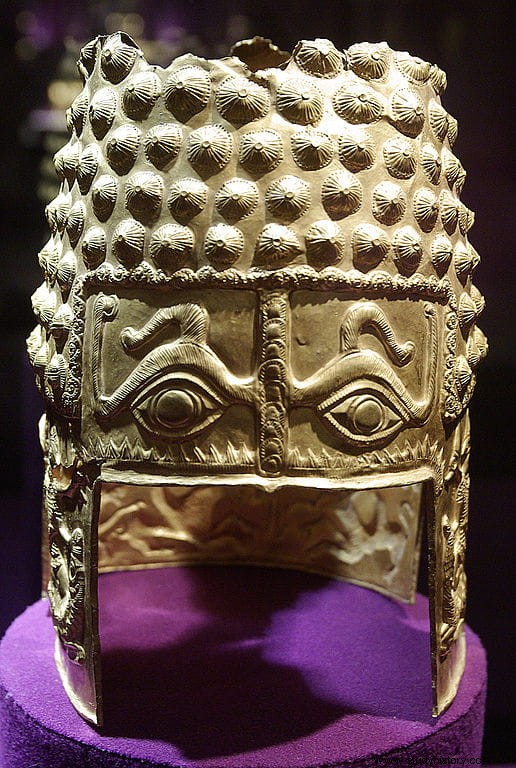In the year 1928 a boy named Traian Simion found, while working in the field near the village of Poiana Coțofenești (present-day Poiana Vărbilău), a unique golden helmet. After being analyzed by researchers from the University of Bucharest, it turned out to be a gold helmet from the Iron Age belonging to the La Tène culture and dated around 400 BC.
Some believe that it is a sacred helmet of Zalmoxis, the main deity of the Getae (a Thracian people of the lower Danube) who had returned from the dead and possibly one of the names of the Thracian Orpheus.
But the general consensus is that it is a work of Geto-Dacian art (two peoples of the Thracian Celt group), of an autochthonous nature and that it must have belonged to a king or a nobleman.

The helmet weighs about 770 grams, is made of gold sheets and decorated with large conical buttons or studs on the top of the skull. It features two huge apotropaic eyes, intended to ward off the evil eye and combat magic spells, with double eyebrows turned to inspire fear.
On the sides of the cheeks shows two ritual scenes. In one the offering of a ram by a man, possibly a priest-king wearing a diadem, kneeling over his body with a short knife.

And in the other what appears to be the offering of a bull. Both, along with the rest of the mythical creatures that decorate the object, come from oriental Iranian-Persian motifs through Greek art.
The pair of creatures represented on the neckguard are associated with the motif of the voracious beast , very common in Assyrian and Etruscan art.
The upper register features a row of three winged, sitting or crouching, ape-like creatures with human faces, long forearms, and tails, identified as sphinxes or griffins.
Geometric motifs such as the rosette, triangles, spirals, and others are specific to Geto-Dacian art.
According to experts, the helmet was made from two pieces of gold plate, produced by cold hammering from a natural, unrefined gold ingot. This is why the hull parts vary in thickness.

The main body has a total height of 24.32 centimeters, with an internal diameter of 18.42 centimeters in the central area (at eye level), 17.6 centimeters on the sides (ears) and 13.5 centimeters in the upper area.
The hull was found damaged, it is missing the upper part, which was curved as shown by the reconstructions carried out by the experts. However, the 1967 Romanian film The Dacians it showed King Decebalus (who lived about 500 years after the helmet's date of creation) wearing a flat-topped version, which is what has passed into popular culture.
In any case, today he is considered one of the main cultural icons of Romania.

However, it does not seem that it was intended to be used in combat, especially since gold has a very low hardness and would have served little as a defense. As is often the case with this type of piece, it is assigned a ceremonial function aimed at highlighting the social level of its wearer.
It is not the only Thracian helmet from the 4th century BC, as four others have been discovered, both gold and silver. The most similar to that of Coțofenești is the Agighiol helm. Both are kept in the Romanian National History Museum in Bucharest.
